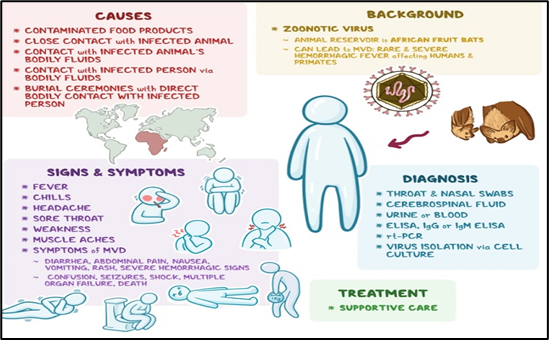Why in news?
- Tanzania has announced its first outbreak of the deadly Marburg virus disease (MVD).
- This was after five people died and three others were infected with the virus in Tanzania’s north-west Kagera region.
What’s in today’s article?
What is the Marburg virus disease?
- According to WHO, Marburg virus disease (MVD), earlier known as Marburg hemorrhagic fever, is a severe, often fatal hemorrhagic fever.
- It is a zoonotic virus that is initially transmitted from animals to humans.
- Marburg, like Ebola, is a filovirus; and both diseases are clinically similar.
- Rousettus fruit bats are considered the natural hosts for the Marburg virus.
- However, as per WHO, African green monkeys imported from Uganda were the source of the first human infection.
- The disease has an average fatality rate of around 50%. However, it can be as low as 24% or as high as 88% depending on virus strain and case management.

What are the symptoms of Marburg virus disease?
- After the onset of symptoms, which can begin anytime between two to 21 days, MVD can manifest itself in the form of high fever, muscle aches and severe headache.
- Around the third day, patients report abdominal pain, vomiting, severe watery diarrhoea and cramping.
- In this phase, the appearance of patients has been often described as “ghost-like” with deep-set eyes, expressionless faces, and extreme lethargy.
- Between days five and seven, patients report bleeding from the nose, and gums and blood appearing in vomit and faeces.
- Severe blood loss leads to death, often between eight to nine days after symptoms begin.
How does it spread?
- Marburg spreads through direct contact (through broken skin or mucous membranes) with infected people’s blood, secretions, organs, or other body fluids.
- It also spreads through surfaces and objects (e.g., bedding, clothing) contaminated with these fluids.
How can Marburg virus disease be diagnosed and treated?
- It is difficult to clinically distinguish MVD from diseases such as malaria, typhoid fever and other viral haemorrhagic fevers.
- However, it is confirmed by lab testing of samples, which like Coronavirus and Ebola are extreme biohazard risks.
- There is no approved antiviral treatment or vaccine for MVD as of now. It can be managed with supportive care.
- According to the WHO, rehydration with oral or intravenous fluids, and treatment of specific symptoms can help prevent death.










